California Nursing Practice Act: Functions and Impact on RN Practice
VerifiedAdded on 2022/08/08
|5
|1141
|24
Essay
AI Summary
This essay analyzes the California Nursing Practice Act (CNPA), outlining its key functions in regulating the scope of practice for Registered Nurses (RNs) in California. The paper explores the CNPA's role in defining medical, interdependent, dependent, and independent nursing functions, as well as its impact on RN responsibilities such as medication administration, patient care, and documentation. The CNPA mandates the California Board of Registered Nursing (CBRN) to oversee these regulations, including licensure requirements. The essay further discusses how the CNPA will influence the student's future nursing practice, emphasizing the importance of legal and ethical compliance, adherence to the scope of practice, and collaboration with healthcare professionals. The paper concludes by highlighting the CNPA's significance in guiding legally and clinically effective RN practice. The essay is formatted in APA style, with a minimum of two references.
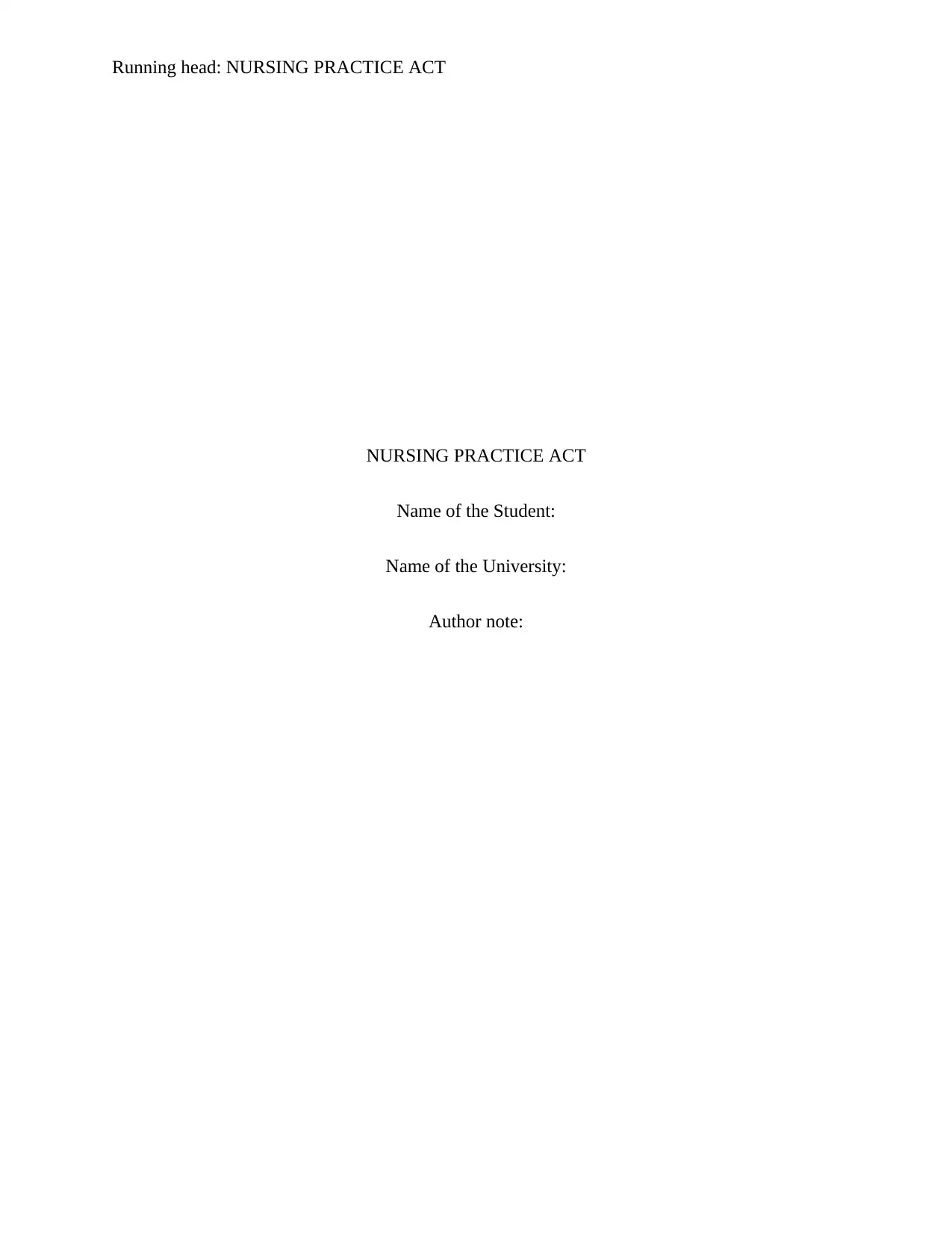
Running head: NURSING PRACTICE ACT
NURSING PRACTICE ACT
Name of the Student:
Name of the University:
Author note:
NURSING PRACTICE ACT
Name of the Student:
Name of the University:
Author note:
Paraphrase This Document
Need a fresh take? Get an instant paraphrase of this document with our AI Paraphraser
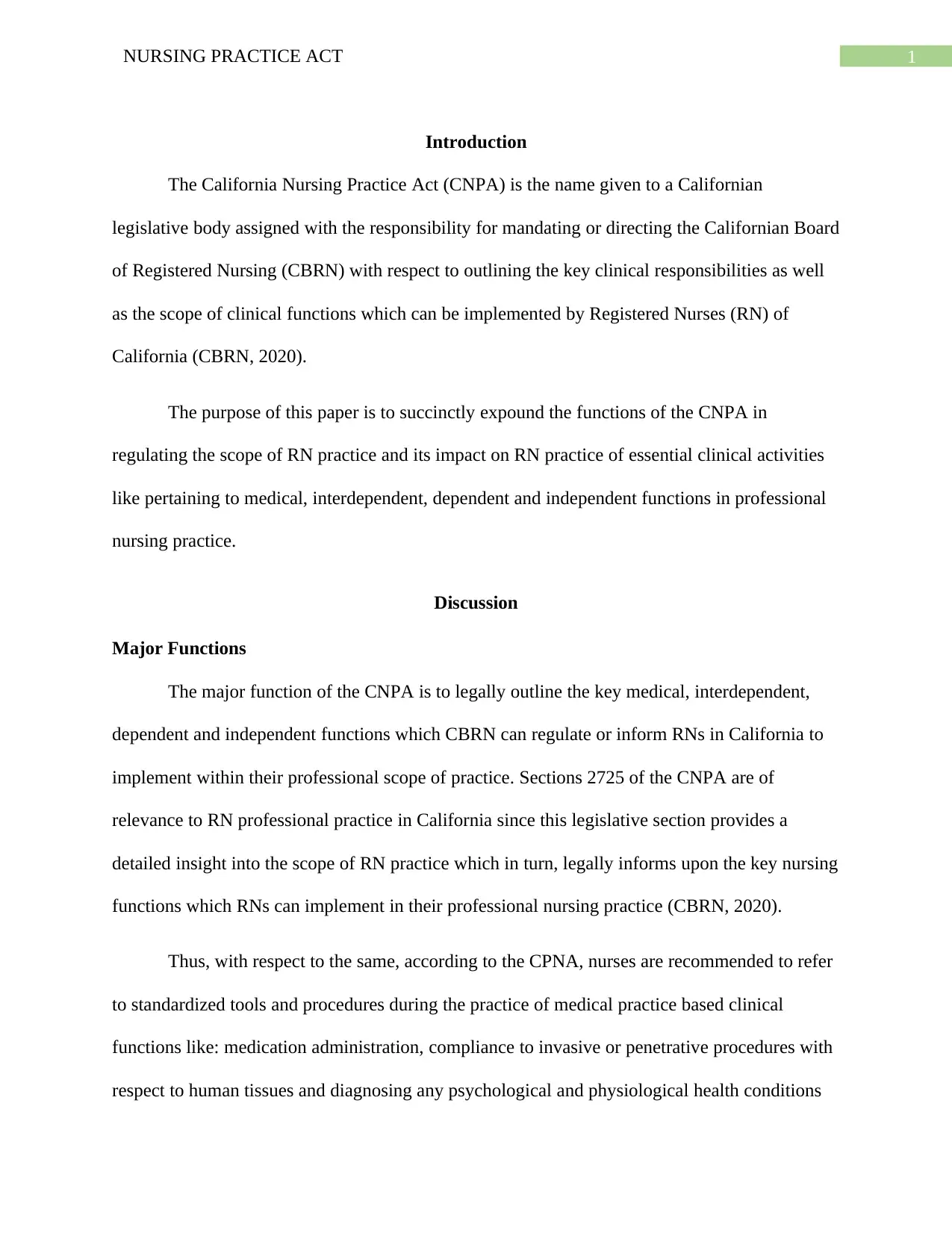
1NURSING PRACTICE ACT
Introduction
The California Nursing Practice Act (CNPA) is the name given to a Californian
legislative body assigned with the responsibility for mandating or directing the Californian Board
of Registered Nursing (CBRN) with respect to outlining the key clinical responsibilities as well
as the scope of clinical functions which can be implemented by Registered Nurses (RN) of
California (CBRN, 2020).
The purpose of this paper is to succinctly expound the functions of the CNPA in
regulating the scope of RN practice and its impact on RN practice of essential clinical activities
like pertaining to medical, interdependent, dependent and independent functions in professional
nursing practice.
Discussion
Major Functions
The major function of the CNPA is to legally outline the key medical, interdependent,
dependent and independent functions which CBRN can regulate or inform RNs in California to
implement within their professional scope of practice. Sections 2725 of the CNPA are of
relevance to RN professional practice in California since this legislative section provides a
detailed insight into the scope of RN practice which in turn, legally informs upon the key nursing
functions which RNs can implement in their professional nursing practice (CBRN, 2020).
Thus, with respect to the same, according to the CPNA, nurses are recommended to refer
to standardized tools and procedures during the practice of medical practice based clinical
functions like: medication administration, compliance to invasive or penetrative procedures with
respect to human tissues and diagnosing any psychological and physiological health conditions
Introduction
The California Nursing Practice Act (CNPA) is the name given to a Californian
legislative body assigned with the responsibility for mandating or directing the Californian Board
of Registered Nursing (CBRN) with respect to outlining the key clinical responsibilities as well
as the scope of clinical functions which can be implemented by Registered Nurses (RN) of
California (CBRN, 2020).
The purpose of this paper is to succinctly expound the functions of the CNPA in
regulating the scope of RN practice and its impact on RN practice of essential clinical activities
like pertaining to medical, interdependent, dependent and independent functions in professional
nursing practice.
Discussion
Major Functions
The major function of the CNPA is to legally outline the key medical, interdependent,
dependent and independent functions which CBRN can regulate or inform RNs in California to
implement within their professional scope of practice. Sections 2725 of the CNPA are of
relevance to RN professional practice in California since this legislative section provides a
detailed insight into the scope of RN practice which in turn, legally informs upon the key nursing
functions which RNs can implement in their professional nursing practice (CBRN, 2020).
Thus, with respect to the same, according to the CPNA, nurses are recommended to refer
to standardized tools and procedures during the practice of medical practice based clinical
functions like: medication administration, compliance to invasive or penetrative procedures with
respect to human tissues and diagnosing any psychological and physiological health conditions
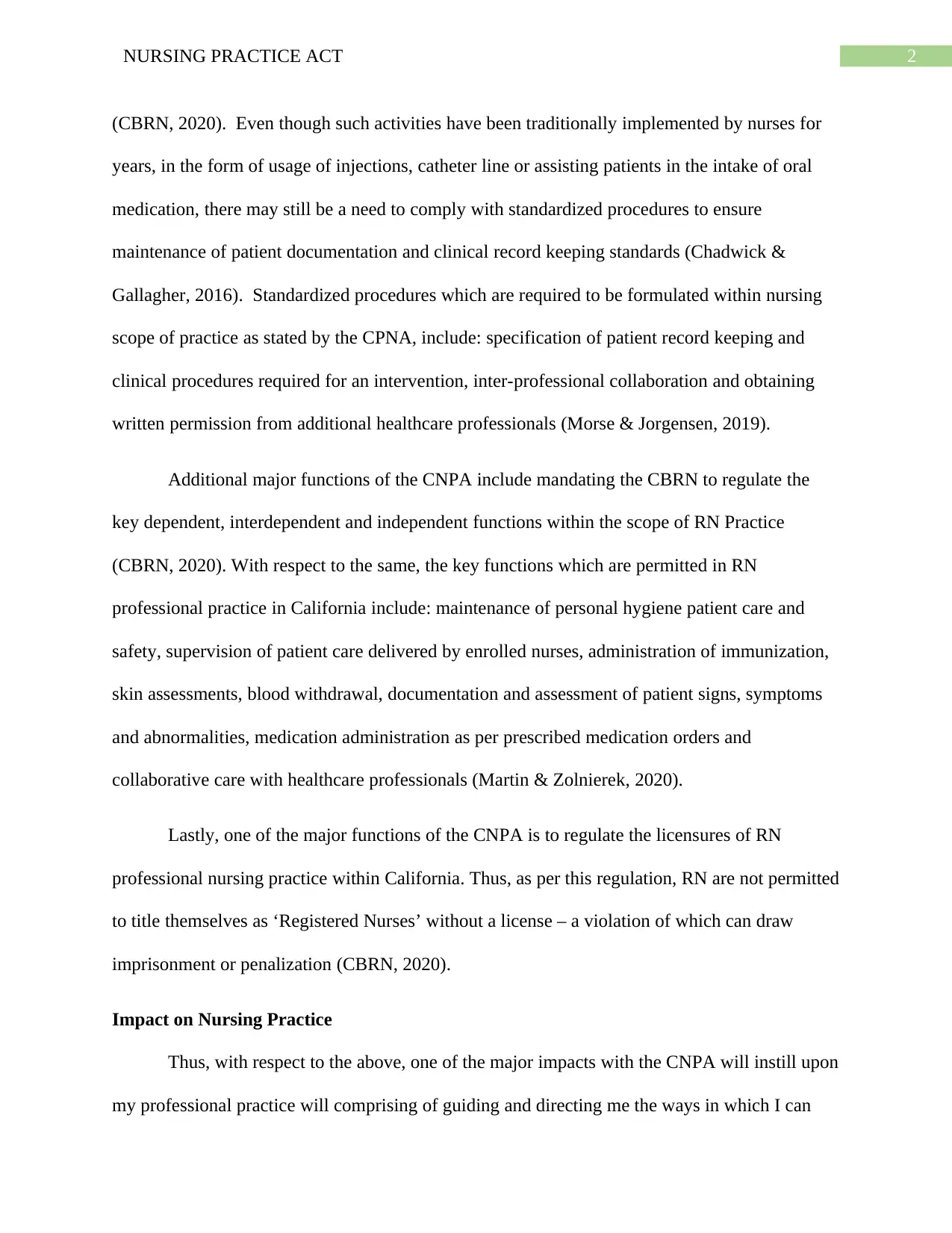
2NURSING PRACTICE ACT
(CBRN, 2020). Even though such activities have been traditionally implemented by nurses for
years, in the form of usage of injections, catheter line or assisting patients in the intake of oral
medication, there may still be a need to comply with standardized procedures to ensure
maintenance of patient documentation and clinical record keeping standards (Chadwick &
Gallagher, 2016). Standardized procedures which are required to be formulated within nursing
scope of practice as stated by the CPNA, include: specification of patient record keeping and
clinical procedures required for an intervention, inter-professional collaboration and obtaining
written permission from additional healthcare professionals (Morse & Jorgensen, 2019).
Additional major functions of the CNPA include mandating the CBRN to regulate the
key dependent, interdependent and independent functions within the scope of RN Practice
(CBRN, 2020). With respect to the same, the key functions which are permitted in RN
professional practice in California include: maintenance of personal hygiene patient care and
safety, supervision of patient care delivered by enrolled nurses, administration of immunization,
skin assessments, blood withdrawal, documentation and assessment of patient signs, symptoms
and abnormalities, medication administration as per prescribed medication orders and
collaborative care with healthcare professionals (Martin & Zolnierek, 2020).
Lastly, one of the major functions of the CNPA is to regulate the licensures of RN
professional nursing practice within California. Thus, as per this regulation, RN are not permitted
to title themselves as ‘Registered Nurses’ without a license – a violation of which can draw
imprisonment or penalization (CBRN, 2020).
Impact on Nursing Practice
Thus, with respect to the above, one of the major impacts with the CNPA will instill upon
my professional practice will comprising of guiding and directing me the ways in which I can
(CBRN, 2020). Even though such activities have been traditionally implemented by nurses for
years, in the form of usage of injections, catheter line or assisting patients in the intake of oral
medication, there may still be a need to comply with standardized procedures to ensure
maintenance of patient documentation and clinical record keeping standards (Chadwick &
Gallagher, 2016). Standardized procedures which are required to be formulated within nursing
scope of practice as stated by the CPNA, include: specification of patient record keeping and
clinical procedures required for an intervention, inter-professional collaboration and obtaining
written permission from additional healthcare professionals (Morse & Jorgensen, 2019).
Additional major functions of the CNPA include mandating the CBRN to regulate the
key dependent, interdependent and independent functions within the scope of RN Practice
(CBRN, 2020). With respect to the same, the key functions which are permitted in RN
professional practice in California include: maintenance of personal hygiene patient care and
safety, supervision of patient care delivered by enrolled nurses, administration of immunization,
skin assessments, blood withdrawal, documentation and assessment of patient signs, symptoms
and abnormalities, medication administration as per prescribed medication orders and
collaborative care with healthcare professionals (Martin & Zolnierek, 2020).
Lastly, one of the major functions of the CNPA is to regulate the licensures of RN
professional nursing practice within California. Thus, as per this regulation, RN are not permitted
to title themselves as ‘Registered Nurses’ without a license – a violation of which can draw
imprisonment or penalization (CBRN, 2020).
Impact on Nursing Practice
Thus, with respect to the above, one of the major impacts with the CNPA will instill upon
my professional practice will comprising of guiding and directing me the ways in which I can
⊘ This is a preview!⊘
Do you want full access?
Subscribe today to unlock all pages.

Trusted by 1+ million students worldwide
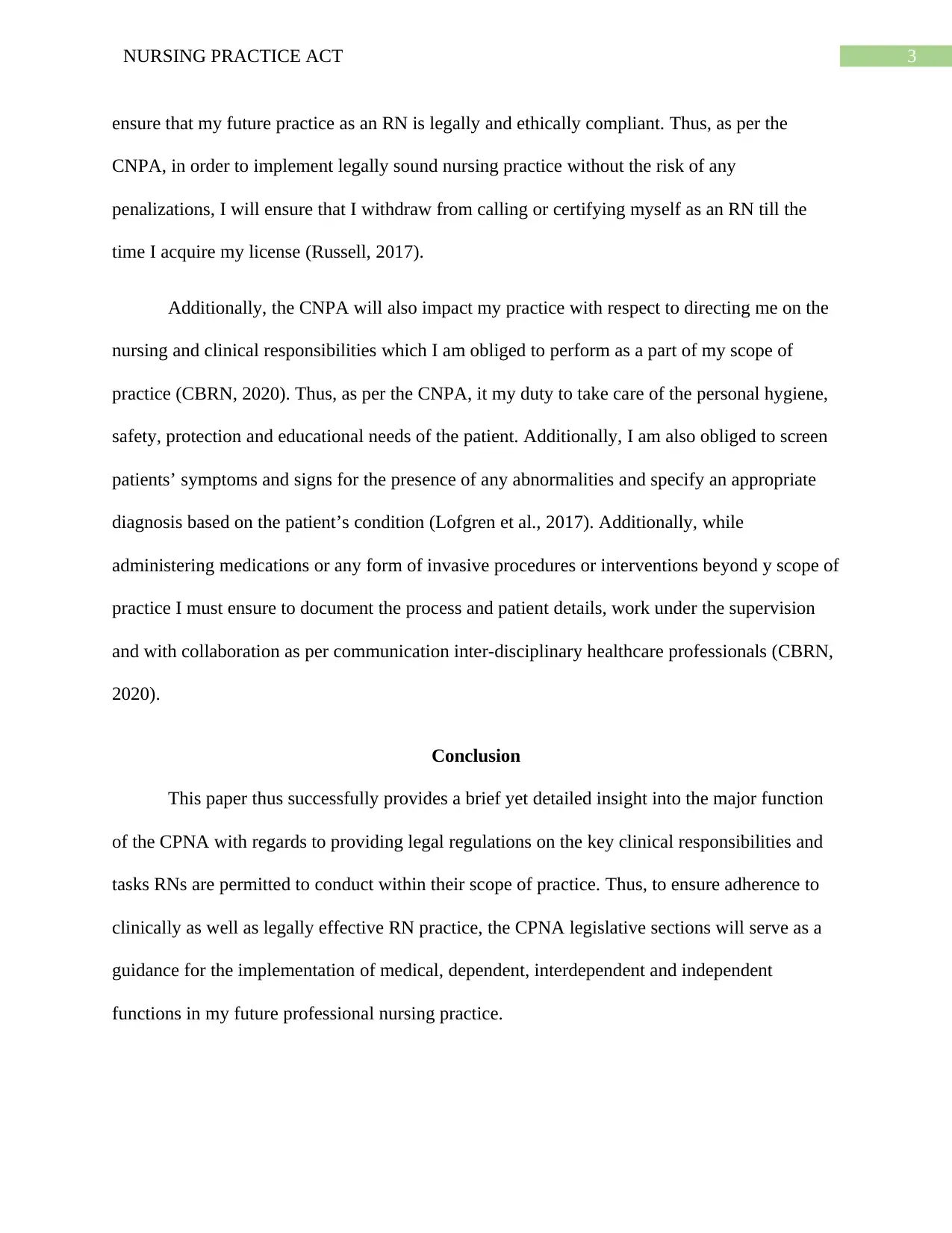
3NURSING PRACTICE ACT
ensure that my future practice as an RN is legally and ethically compliant. Thus, as per the
CNPA, in order to implement legally sound nursing practice without the risk of any
penalizations, I will ensure that I withdraw from calling or certifying myself as an RN till the
time I acquire my license (Russell, 2017).
Additionally, the CNPA will also impact my practice with respect to directing me on the
nursing and clinical responsibilities which I am obliged to perform as a part of my scope of
practice (CBRN, 2020). Thus, as per the CNPA, it my duty to take care of the personal hygiene,
safety, protection and educational needs of the patient. Additionally, I am also obliged to screen
patients’ symptoms and signs for the presence of any abnormalities and specify an appropriate
diagnosis based on the patient’s condition (Lofgren et al., 2017). Additionally, while
administering medications or any form of invasive procedures or interventions beyond y scope of
practice I must ensure to document the process and patient details, work under the supervision
and with collaboration as per communication inter-disciplinary healthcare professionals (CBRN,
2020).
Conclusion
This paper thus successfully provides a brief yet detailed insight into the major function
of the CPNA with regards to providing legal regulations on the key clinical responsibilities and
tasks RNs are permitted to conduct within their scope of practice. Thus, to ensure adherence to
clinically as well as legally effective RN practice, the CPNA legislative sections will serve as a
guidance for the implementation of medical, dependent, interdependent and independent
functions in my future professional nursing practice.
ensure that my future practice as an RN is legally and ethically compliant. Thus, as per the
CNPA, in order to implement legally sound nursing practice without the risk of any
penalizations, I will ensure that I withdraw from calling or certifying myself as an RN till the
time I acquire my license (Russell, 2017).
Additionally, the CNPA will also impact my practice with respect to directing me on the
nursing and clinical responsibilities which I am obliged to perform as a part of my scope of
practice (CBRN, 2020). Thus, as per the CNPA, it my duty to take care of the personal hygiene,
safety, protection and educational needs of the patient. Additionally, I am also obliged to screen
patients’ symptoms and signs for the presence of any abnormalities and specify an appropriate
diagnosis based on the patient’s condition (Lofgren et al., 2017). Additionally, while
administering medications or any form of invasive procedures or interventions beyond y scope of
practice I must ensure to document the process and patient details, work under the supervision
and with collaboration as per communication inter-disciplinary healthcare professionals (CBRN,
2020).
Conclusion
This paper thus successfully provides a brief yet detailed insight into the major function
of the CPNA with regards to providing legal regulations on the key clinical responsibilities and
tasks RNs are permitted to conduct within their scope of practice. Thus, to ensure adherence to
clinically as well as legally effective RN practice, the CPNA legislative sections will serve as a
guidance for the implementation of medical, dependent, interdependent and independent
functions in my future professional nursing practice.
Paraphrase This Document
Need a fresh take? Get an instant paraphrase of this document with our AI Paraphraser
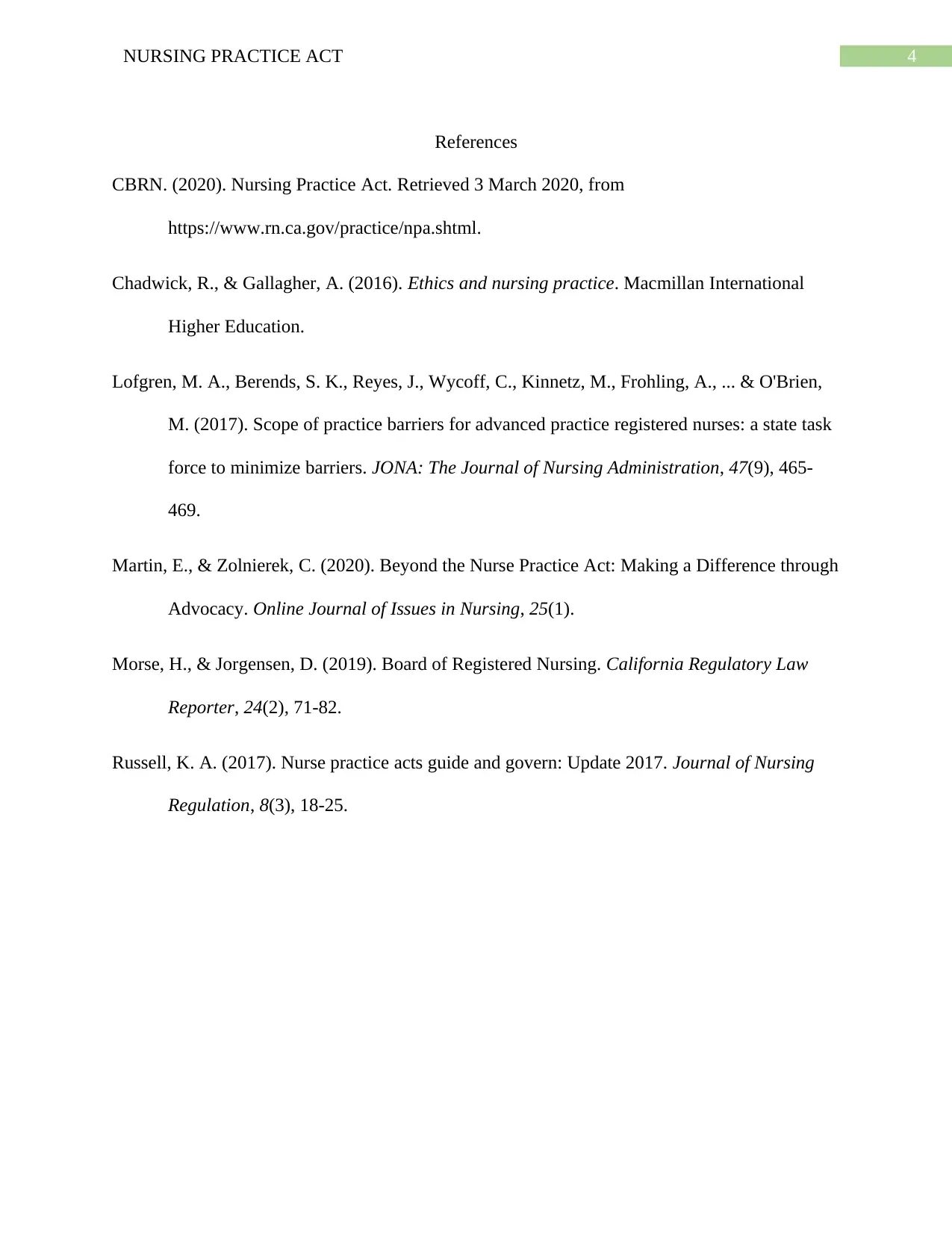
4NURSING PRACTICE ACT
References
CBRN. (2020). Nursing Practice Act. Retrieved 3 March 2020, from
https://www.rn.ca.gov/practice/npa.shtml.
Chadwick, R., & Gallagher, A. (2016). Ethics and nursing practice. Macmillan International
Higher Education.
Lofgren, M. A., Berends, S. K., Reyes, J., Wycoff, C., Kinnetz, M., Frohling, A., ... & O'Brien,
M. (2017). Scope of practice barriers for advanced practice registered nurses: a state task
force to minimize barriers. JONA: The Journal of Nursing Administration, 47(9), 465-
469.
Martin, E., & Zolnierek, C. (2020). Beyond the Nurse Practice Act: Making a Difference through
Advocacy. Online Journal of Issues in Nursing, 25(1).
Morse, H., & Jorgensen, D. (2019). Board of Registered Nursing. California Regulatory Law
Reporter, 24(2), 71-82.
Russell, K. A. (2017). Nurse practice acts guide and govern: Update 2017. Journal of Nursing
Regulation, 8(3), 18-25.
References
CBRN. (2020). Nursing Practice Act. Retrieved 3 March 2020, from
https://www.rn.ca.gov/practice/npa.shtml.
Chadwick, R., & Gallagher, A. (2016). Ethics and nursing practice. Macmillan International
Higher Education.
Lofgren, M. A., Berends, S. K., Reyes, J., Wycoff, C., Kinnetz, M., Frohling, A., ... & O'Brien,
M. (2017). Scope of practice barriers for advanced practice registered nurses: a state task
force to minimize barriers. JONA: The Journal of Nursing Administration, 47(9), 465-
469.
Martin, E., & Zolnierek, C. (2020). Beyond the Nurse Practice Act: Making a Difference through
Advocacy. Online Journal of Issues in Nursing, 25(1).
Morse, H., & Jorgensen, D. (2019). Board of Registered Nursing. California Regulatory Law
Reporter, 24(2), 71-82.
Russell, K. A. (2017). Nurse practice acts guide and govern: Update 2017. Journal of Nursing
Regulation, 8(3), 18-25.
1 out of 5
Related Documents
Your All-in-One AI-Powered Toolkit for Academic Success.
+13062052269
info@desklib.com
Available 24*7 on WhatsApp / Email
![[object Object]](/_next/static/media/star-bottom.7253800d.svg)
Unlock your academic potential
Copyright © 2020–2025 A2Z Services. All Rights Reserved. Developed and managed by ZUCOL.




